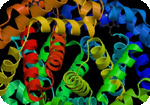| Tuesday, 13 May 2025 Home • About Us • Contact Us |
|
|
|
You are here:
Enzymes are complex proteins that act as catalysts in almost every biochemical process that takes place in the body. Their activity depends on the presence of adequate levels of vitamins and minerals, particularly magnesium. An enzyme-deficient diet has been found to over-work the pancreas and lead to illness and a shortened lifespan.
There are three classifications of enzymes:
Research has revealed the importance of enzymes found in raw food, particularly raw fermented food. These enzymes help start the process of digestion and reduce the body's need to produce digestive enzymes. A diet high in cooked foods is usually an enzyme-poor diet. This puts strain on the pancreas, by constantly oversimulating it to produce enzymes that should be in foods, and thus inhibits its functioning. Over time, research has found that this also results in shortened lifespan, illness and lowered resistance to stress. Sources of Enzymes Grains, nuts, legumes and seeds are rich in enzymes, as well as other nutrients, but they also contain enzyme inhibitors. These can put great strain on the digestive system, so they need to be deactivated. sprouting, soaking in warm, acidic water, culturing and fermenting, are all processes that deactivate enzyme inhibitors, thus making nutrients in grains, seeds and nuts more readily available. See Soak Your grains for Maximum Benefit Most fruits and vegetables contain little enzymes, but some plant foods that have high enzyme content include extra virgin olive oil and other refined oils, raw honey, grapes, figs, avocados, dates, bananas, pineapple, papaya, kiwi and mangos. A good way to incorporate beneficial enzymes into the diet is pickle or ferment fruits and vegetables, eat cultured dairy products, soak grains before using, and marinate meat before cooking it, all which helps to predigest the food by enzyme activity and therefore eases the digestive process.
Link to this article: Show: HTML Link • Full Link • Short Link
Related Articles:
You must be registered and logged in to comment. |
|
 |
 | |
|
|








